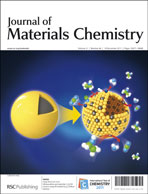Poly(ethylene oxide)-functionalized aluminum (Al) cathodes of tunable electron-injection capabilities are reported in this study for the fabrication of high-performance polymer light-emitting diodes (PLEDs). The composite cathodes are prepared by thermally co-evaporating poly(ethylene glycol) dimethyl ether (PEGDE, Mnca. 2000) polymer with Al metal simultaneously in vacuum as the cathode buffer. We attribute the formation of the carbide-like/Al complex as characterized by X-ray photoelectron spectroscopy (XPS) to the instant chemical reactions between the ethylene oxide functional groups with Al, which markedly enhances the device performance. The electron-injection capabilities of PEGDE : Al/Al cathodes are correlated with the contents of the carbide-like/Al complex in the buffer layer and can, therefore, be modulated by varying the co-evaporation ratios of PEGDE and Al. The luminous efficiency of green polyfluorene-based PLEDs applying an PEGDE : Al (2 : 1)/Al cathode is of 10.46 cd A−1, which is much higher than that of ∼0.04, 5.19, 6.40 cd A−1 for PLEDs with Al, PEGDE/Al and calcium/Al cathodes, respectively. This research leads to an alternative cathode design, free of salts, additives, complicated synthesis, and of tunable electron-injection capabilities to balance the opposite charge carriers for fabricating high-performance PLEDs.

You have access to this article
 Please wait while we load your content...
Something went wrong. Try again?
Please wait while we load your content...
Something went wrong. Try again?


 Please wait while we load your content...
Please wait while we load your content...